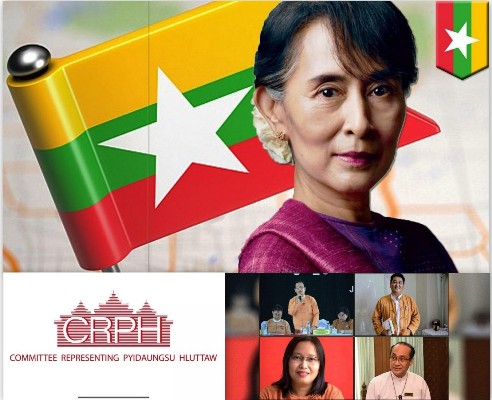After the coup in Myanmar, different forces have risen to protest against the junta through marches, use of social-media or through armed means.
The internet shutdown was expanded by the military junta in Myanmar in response to the dissent against the coup. The protesters in the dissent have vowed that they would unseat the generals who have carried out the coup. Radio-frequencies, offline internet resources, providers of text message, & news alerts are being used by the dissenters to circumvent the recent curbs on the internet. The latest internet-curb has limited the web-access to fixed-line services only.
The order to the Telecom firms (in Myanmar) to cut the wireless broadband was not announced or explained by the military. This order adds to the ban on mobile data through which the nation-wide movement has been mobilized over the social media platforms. The ban is not unsurprising as the social-media has allowed the spread of images that show the junta’s lethal suppression of the protesters who are mostly youth. The crackdown on the dissenters has led to a number of causalities which have crossed 535, as per Association for Political Prisoners. The junta’s crackdown has also led to the detention of more than 2500 people. A call for “flower-strike” was spread on Thursday, at bus-stops where protesters who were killed by security forces had left for their last journeys.
Reactions from International community on the violence
The UN Security Council, on Thursday, expressed deep concern at the rapidly deteriorating situation in Myanmar. It condemned the use of violence against the peaceful protesters & the killings of hundreds of civilians, including women and children. Announcing sanctions against one of the military’s biggest conglomerates, Myanmar Economic Corporation (MEC), British foreign minister, Dominic Raab, accused the military-junta which carried out the coup of “the wanton killing of innocent people, including children.” International Federation of Red Cross and Red Crescent Societies has called for greater protection for medical workers. It also warned that Myanmar Red Cross first aiders have been “wrongfully arrested, intimidated or injured.” The body also added that Red Cross property and ambulances had been damaged; & in this regard, the IFRC’s Asia Pacific regional director Alexander Matheou stated, “This is unacceptable. Health workers should never be a target. They should be granted unrestricted humanitarian access to people in need.”
Also Read: Coup in Myanmar: Overview of the Background & the conflicts in which it occurred
Groups in protests and uprisings against the coup
Apart from the escalation of the violence on the streets against the protesters, there have been involvements of the military in stamping out protests by various ethnic communities in the country. The forces of junta are on the way of colliding with Karen people. Airstrikes by the Myanmar forces, Tatmadaw, have killed six villagers in the country’s Kayin state, which is a stronghold of Karen people. Thousands of Karen people had tried to flee to Thailand and they were turned back by Thai authorities. In the southeastern Karen state, one of the strongest groups, the Karen National Union (KNU), said that it is responding to appeals for help from coup opponents by sending fighters to protect protesters. Its troops are attacking Myanmar army positions and cutting off supply routes, in what the group says is a response to encroachment on its territory. KNU said that on March 27 and 28, the junta’s military has also bombed villages in Hpapun district, killing and injuring some civilians, including children, and forcing about 10,000 people to flee their homes. Three rebel armies in Myanmar have warned that they might allow a cease-fire lapse and would fight to protect civilians from government forces. Early Wednesday, in northern Myanmar, the Kachin guerrillas had attacked a police outpost. This points to the worsening association of ethnic minority armed forces in the country’s movement which seeks to unseat the junta. Prior to that Karen guerrillas have seized an army outpost, after which the airstrikes came pounding on Karen villages. After the airstrikes, Thai authorities have pushed back more than 2,000 people to the Ei Tu Hta displacement camp in Hpapun district.
Many of the major groups including the Karen, Kachin & the Arakan Army of Rakhines have denounced the coup publicly. Additionally, they have also stated that they would protect the protesters in the regions they control. The leaders of the protesting movement are seeking an alliance with the armed groups of various minorities to mount pressure on the junta. Committee Representing the Pyidaungsu Hluttaw is the government in exile which is seeking the alliance in favour of National league for democracy (NLD) whose government was overthrown in the coup. The Acting foreign minister, Zir Mar Aung representing the NLD leaders of the government in exile, recently stated that the government envisioned by them is of a coalition-type, a national federal form centred around the idea of democracy. This underground self-style alternate government has declared the country’s 2008 constitution void. An ex-fighter with the Karenni National Progressive Party, Isaac, said that he had spent years battling government forces in the eastern jungles before settling in northern Thailand. Soldiers like him, have fought for decades for greater autonomy for minorities from a central government and army dominated by majority Bamar Buddhists. He is also contemplating a return to war against the junta adding that, if all the ethnic armed groups unite, they can win.
The coming weeks, maybe months would tell how the battles between the junta which carried out the coup and the various protesting forces would shape the political future of Myanmar.





